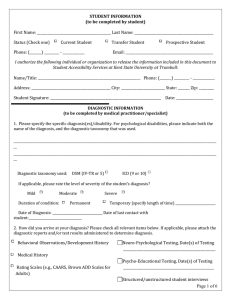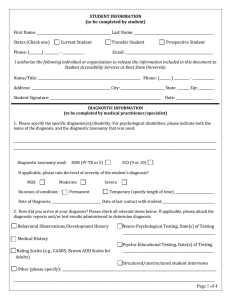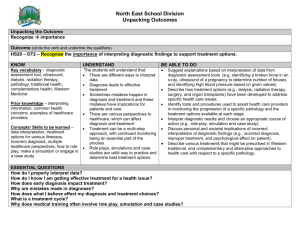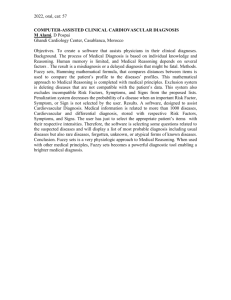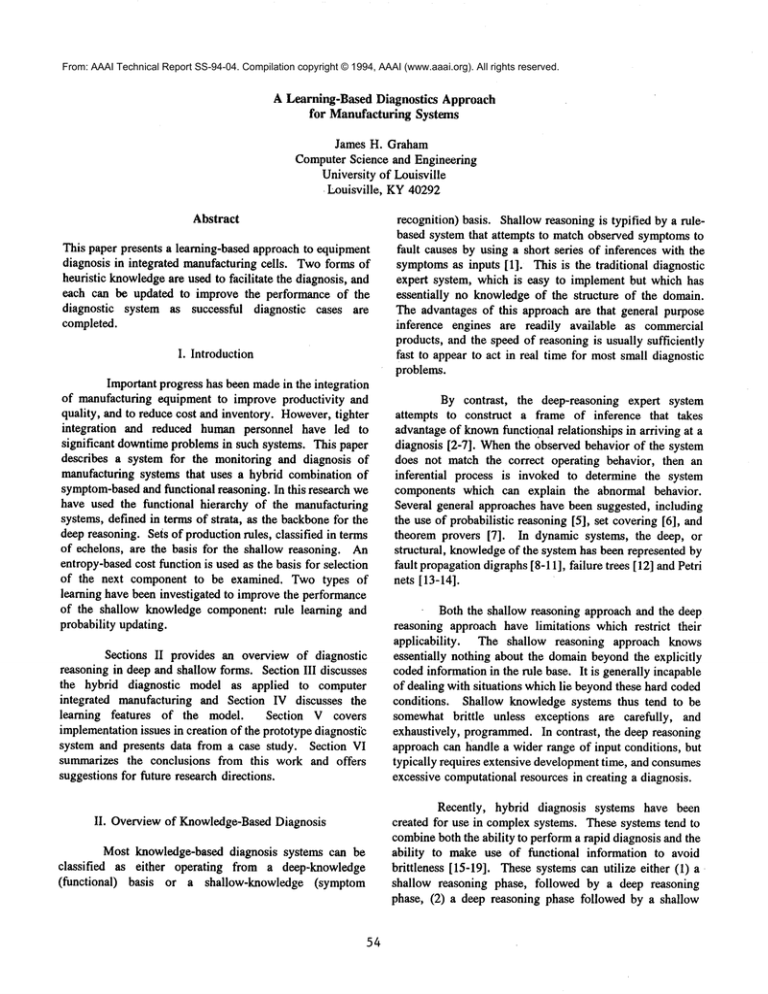
From: AAAI Technical Report SS-94-04. Compilation copyright © 1994, AAAI (www.aaai.org). All rights reserved.
A Learning-Based Diagnostics Approach
for Manufacturing Systems
James H. Graham
Computer Science and Engineering
University of Louisville
Louisville, KY40292
Abstract
This paper presents a learning-based approach to equipment
diagnosis in integrated manufacturing ceils. Twoforms of
heuristic knowledgeare used to facilitate the diagnosis, and
each can be updated to improve the performance of the
diagnostic system as successful diagnostic cases are
completed.
I. Introduction
Important progress has been madein the integration
of manufacturing equipment to improve productivity and
quality, and to reduce cost and inventory. However,tighter
integration and reduced human personnel have led to
significant downtimeproblems in such systems. This paper
describes a system for the monitoring and diagnosis of
manufacturing systems that uses a hybrid combination of
symptom-based
and functional reasoning. In this research we
have used the functional hierarchy of the manufacturing
systems, defined in terms of strata, as the backbonefor the
deep reasoning. Seis of production rules, classified in terms
of echelons, are the basis for the shallow reasoning. An
entropy-basedcost function is used as the basis for selection
of the next component to be examined. Two types of
learning have been investigated to improve the performance
of the shallow knowledge component: rule learning and
probability updating.
Sections II provides an overview of diagnostic
reasoning in deep and shallow forms. Section III discusses
the hybrid diagnostic model as applied to computer
integrated manufacturing and Section IV discusses the
learning features of the model. Section V covers
implementationissues in creation of the prototype diagnostic
system and presents data from a case study. Section VI
summarizes the conclusions from this work and offers
suggestions for future research directions.
II. Overview of Knowledge-BasedDiagnosis
Most knowledge-based diagnosis systems can be
classified as either operating from a deep-knowledge
(functional)
basis or a shallow-knowledge (symptom
54
recognition) basis. Shallowreasoning is typified by a rulebased system that attempts to match observed symptomsto
fault causes by using a short series of inferences with the
symptomsas inputs [1]. This is the traditional diagnostic
expert system, which is easy to implement but which has
essentially no knowledgeof the structure of the domain.
The advantages of this approach are that general purpose
inference engines are readily available as commercial
products, and the speed of reasoning is usually sufficiently
fast to appear to act in real time for most small diagnostic
problems.
By contrast, the deep-reasoning expert system
attempts to construct a frame of inference that takes
advantage of knownfunctional relationships in arriving at a
diagnosis [2-7]. Whenthe observed behavior of the system
does not match the correct operating behavior, then an
inferential process is invoked to determine the system
components which can explain the abnormal behavior.
Several general approaches have been suggested, including
the use of probabilistic reasoning [5], set covering [6], and
theorem provers [7]. In dynamic systems, the deep, or
structural, knowledgeof the system has been represented by
fault propagationdigraphs [8-11], failure trees [12] and Petri
nets [13-14].
Both the shallow reasoning approach and the deep
reasoning approach have limitations which restrict their
applicability.
The shallow reasoning approach knows
essentially nothing about the domainbeyond the explicitly
coded information in the rule base. It is generally incapable
of dealing with situations which lie beyondthese hard coded
conditions. Shallow knowledge systems thus tend to be
somewhat brittle unless exceptions are carefully, and
exhaustively, programmed.In contrast, the deep reasoning
approach can handle a wider range of input conditions, but
typically requires extensive developmenttime, and consumes
excessive computational resources in creating a diagnosis.
Recently, hybrid diagnosis systems have been
created for use in complexsystems. These systems tend to
combineboth the ability to performa rapid diagnosis and the
ability to make use of functional information to avoid
brittleness [15-19]. These systems can utilize either (1)
shallow reasoning phase, followed by a deep reasoning
phase, (2) a deep reasoning phase followed by a shallow
reasoning phase, or (3) someother combination of deep and
shallow reasoning. Lee [18-19], for example, suggested a
deep search based on system interconnections, leading to
individual shallow knowledgebases for diagnosis of specific
subcomponents.
One of the remaininig shortcomings of knowledgebased diagnosis is the problemof acquiring the experiential
knowledge for the shallow knowledge bases. Although
machine learning has been investigated for some time in
various areas of artificial intelligence, the literature on
applications of learning techniques to diagnostic reasoning
systems is relatively scarce. PazTani [20] discusses an
application of failure-driven learning to the construction of
a diagnostic knowledge base. Koseki [21] describes a
model-baseddiagnostic system which uses explanation based
learning to generalize from single training samples. The
AQ11programof Michalski [22] demonstrated the ability to
learn the rules for diagnosis of soybeandisease from training
samples. The balance of this paper will discuss a new
approach to the application of knowledge-basedlearning in
improving the performance of a fault diagnostic system for
computer integrated manufacturing.
III.
Hybrid CIMDiagnostic Algorithm
Using the notation of Mesarovic [14], to describe
the organization of the hybrid diagnostic system, the
functional hierarchy of the manufacturing system is
represented as a multistrata form, in whicheach level in the
hierarchy represents a newlevel of functional decomposition
of the system. This information is typically available from
the design specifications for the system. Eachterminal node
would be associated with a physical subsystem of the
manufacturing process and would have an associated deep
and shallow knowledge bases. The shallow knowledge
componentis represented in multiechelon form.
the associated deep knowledgebases. Incoprorate any top
level diagnostic information into a rule-based knowledge
base. (Note - this is typically doneoff-line)
Step 2: Whena symptomis observed, attempt to localize
the fault to a specific subcomponent
by checkingfirst the top
level shallow knowledgebase, and then, if necessary, use
top level deep knowledgeto identify a faulty subcomponent.
Step 3: At the sucomponent level, check the shallow
knowledge base for a failure mode. Use cost weighted
entropy to make selection of test procedure, if multiple
failure modesexist.
Step 4: If Step 3 fails, then use the deep reasoning fault
propagation algorithm to determine a fault candidate set for
the subeomponent.
Step 5: Physically test the indicated unit for the fault
indicated.
Step 6: Based upon the results from step 5, update the
diagnostic rules, using either:
a. rule updating procedures, or
b. rule probability updating procedures.
In step 3 of the hybrid diagnosis algorithm, the cost
weighted entropy criterion is used to choosethe next part of
the shallow knowledge base to activate. This entropy
criterion gives the maximum
fault discernmentper unit cost,
and is defined by the following equations:
t
Hijk(w’P)=-E Wi+l,k,x Pi÷l,k,x ln Pi÷l,k,x
Xffil
t
where wi÷leO,~,Pi÷I~.~= 1.
x=l
In a good system design, a numberof the possible
failure points will be instrumented with sensors, and the
failure modecan be isolated to a specific subcomponent
with
a single rule in the top level shallow knowledge base.
However, it is not usually possible to give complete
coverage to failure points by sensors, and in somecases, one
fault may trigger fault symptomsin other subcomponents
through fault propagation. In these cases, methods based
upon the use of fault propagation digraphs [8-11], can be
used as a top level deep reasoning tool to isolate the proper
subcomponent.
The detailed steps in the diagnostic process are
given as follows:
This entropy, a modification of the standard Shannon
entropy equation, is calculated from the failure probabilities
associated with the k-th groupof the i-th echelonof strata j.
The weighting factor, w, is a normalized cost, determined
by dividing the actual cost of a measurement, by the
maximum of the set of measurement costs for all
componentsat the current rule level. Ties are broken, by
choosing the lowest cost in absolute terms. Based upon the
statistical properties of entropy, the following result can be
established.
Theorem1 - Whena choice between different tests must be
made, choosing the test with the lowest cost weighted
entropy guarantees the greatest discrimination per unit test
Step 1: Construct a functional hiearachy of the system and
55
cost.
Proof - Withunit weightingfactors (i.e. all tests have equal
cost), the formula is the standard Shannonentropy, which
gives maximum
information for the lowest entropy value.
The weighting factors are all normalized to fall between 0
and 1.0, thus they tend only to scale the additive terms in
the entropy results.
IV. Learning Capabilities
4.1 Conversion6f a diagnostic case into rule form
A confirmed diagnostic case is represented as
D(S,C), where S = {sis is a subdevice sensed to be
abnormal} is the set of symptoms; and C = {clc is a
subdevice whose failure has been confirmed} is the set of
causes or subdevices whosecollective failure has caused the
occurrence of the symptomsin S.
2) The antecedent of the new rule $1 is the same as the
antecedent of an existing rule; and the consequentCI of the
new rule is not the same as the consequent of the existing
rule. Let the newrule be :
If $1 then C1
and the existing rule be :
If $2 then C2
Then
$1 = S2 and C1 ~ C2,
In this case the heuristic contained in the newrule
is integrated with the existing knowledgeas follows:
a. B = B td Cl if CI ~ B.
b. ~(Sl) = ~(Sl) U
c. Update Pi, for i = 1, n + I, where n is the
numberof existing consequent of $1.
3) The consequent of the new rule C1 is the same
as the consequentof an existing rule; and the antecedent $1
of the new rule is different from the antecedent of the
existing rule. Let the newrule be :
lf S1 then C1
and the existing rule be :
If $2 then C2
Two types of rules can be extracted from a
diagnostic ease D(S, C). The first type of rule has the
following form:
If {sl,s2 ..... sn} then c
where n = I s I, I cl = 1, andC= (c1. In this case one
failed subdevieec caused all the symptoms;i.e. there is only
one failure source. The experience or heuristic expressed by
the rule says that if the sensors or alarms attached to
subdevices sl through sn go off, then possibly the subdevice
c is the failure source.
Then
C1 = C2 and S1 ~ {ot]If ot Then C1 is an existing
rule}
In this case the heuristic contained in the newrule
is integrated with the existing knowledgeas follows:
a. A = A O Sl if Sl q~ A
b. 8(S1) = {{(7111
c. Let p = 1. O for the newly established rule.
In the secondcase there are multiple failure sources
or I C[ > 1. The rule extracted takes the following form:
If {sl,s2 ..... sn} then {cl,c2,...,cm}
where n = I SI and m = ]C[. This rule says that if
subdevices sl through sn are sensed abnormal, then possibly
subdevices cl through cmare the failure sources.
4) Neither the antecedent nor the consequent of the new
rule can be found in the existing rule base. Let the new
rule be
If $1 then C1
Then
S1 q~ A and C1 q~ B
In this case the rule
If $1 then C1
is added to the rule base as follows:
a.A=A k) SI
a. B = B td C1
c. ~(S1) = {CI}
d. Let p = 1.0for the newly established rule.
4.2 Integration of a new rule into the knowledgebase
This is the most important step in the process of
automatic diagnostic knowledge acquisition and rule
updating. The following four cases are considered:
1) The new rule already exists in the current knowledge
base. In this case the probability associated with the rule in
the knowledgebase is adjusted to reflect the fact that the
rule has been reinforced so that more weight should be given
to it in future diagnosis. This has a bearing on interpreting
results of shallow reasoning whenseveral rules fire at the
same time, or the same set of symptomsleads to several
different sets of failure sources. This is discussed in more
detail in section 4.3.
4.3 Updating Rule Probabilities
Wheneverthe rule leads to a correct diagnosis, the
probability of applying that rule should be reinforced;
otherwise the probabilities of other applicable rules should
56
be reinforced. The reinforcement equations are:
several reasons. The hierarchical nature of the deepreasoning diagnosis networkwas a natural for the class
inheritance features of the object-oriented approach. The
failure probabilities and associated cost values were easily
stored as slot values in the units representing the
associated components. The computation of the entropybased cost functions were performed by attached
procedures (methods) as required. Finally, the modular
structure of the resulting software is highly flexible and
adaptable to other diagnostic tasks. Althoughthe initial
implementation was done in KEE,other object-oriented
languages such as C + + could be used for commercial
implementationof this system.
pi(k +I)=pi(k)+X(kI)
[ Y~(
k) l
-(k)
P] fo
rall
where Y(k) is one if the componentis faulty and zero
otherwise.
These equations have the format of classical
stochastic approximations, which leads to the following
theorem.
Theorem2 - If the series X obeys the Dvoretsky
conditions [24],
1.
lira
A typical computerintegrated manufacturing
system will include machining, assembly, material
handling and inspection operations. The CIMtestbed at
the Factory AutomationLaboratory at the University of
Louisville, includes a Bridgeport MachiningCenter, a
Cincinnati Milacron lathe, a GCASCARA
robot, a
General Electric P50 process robot, and a Scantek
conveyor system. This testbed allows the investigation of
a wide range of manufacturing cell configurations for
metalworking and/or assembly.
X(n) --
2.
X(n)~- ,0
11"*°°
kffi-I
~m n
3. !I--,oo k-I x (k)<
the p’s will converge to the true probability values with
probability one.
Proof - The probabilities, p, maybe regarded as
unknown,but fixed, parameters of the manufacturing
system. The update equation, using a series that meets
conditions 1-3 above, then meets the requirements for the
contraction mappingspecified by Dvoretsky’s theorem for
general stochastic approximations[25].
Several simulations were conducted of a typical
knowledge-baseddiagnostic search for a problem with the
material handling system. A search through the deep
knowledgebase, leads to the F32 strata which is a
terminal deep knowledge node. Shallow knowledge base
Rill is activated at this point, and the cost weighted
entropies are computed for the R211 and R212. Now
addition of new rules and update of the probabilities can
be performed.
There are several choices for the correction
coefficient series to satisfy the requirements of Theorem
2. The harmonicseries is widely used in stochastic
approximationapplications, and was used for the initial
case studies in this research, but it is by no meansthe
only option.
VI. Conclusions and Future Directions
This paper has described a methodologyfor
hybrid diagnostic search in computerintegrated
manufacturing systems with a two phase learning system
to update the rule-based diagnostic knowldedge
component.Initial testing with the KEEprototype
indicates that the approachis both effective and efficient
for determining faults in a mediumsized manufacturing
workcell. Future work will involve additional refinement
and testing of the learning features, as there appear to be
several additional learning possibilies within the hybrid
frameworkthat can be investigated.
As the system runs, the diagnosis efficiency will
increase, because the probabilities and entropy cost values
becomemore accurate in directing the diagnostic system
toward the componentmost likely to be faulty. Also, if
there is a change in the system, such as an update of one
componentto makeit more reliable, the system will
automatically begin to update that component’sfailure
probabilties to reflect this change.
V. Implementation and System Case Study
The object-oriented programmingapproach was
chosen for the implementationof the diagnosis system for
57
References
[1] L. Brownston, et al, ProgrammingExpert Systems in
OPS5: An Introduction to Rule-Based Programming,
Reading, MA:Addison-Wesley, 1985.
[2] R. Davis, "Diagnostic Reasoning Based Upon
Structure and Behavior,n Artificial Intelligence, 24(1-3),
1984, pp. 347-410.
[3] R. Reiter, " A Theory of Diagnosis from First
Principle, n Artificial Intelligence, 32(1), 1987, pp. 57-95.
[4] R. Milne, "Strategies for Diagnosis," IEEE
Transactions on Systems, Manand Cybernetics, 17(3),
1987, pp. 333-339.
[13] J. F. Watson, A.A. Desrochers, "Applying
Generalized Stochastic Petri Nets to Manufacturing
Systems Containing Non-exponential Transition
Functions," IEEE Transactions on Systems, Man, and
Cybernetics, Vol. 6, Sept./Oct. 1991, pp. 1008-1017.
[14] M.C. Zhou, F. DiCesare, A.A. Desrochers, "A
Hybrid Methodologyfor Synthesis of Petri Net Modelsfor
Manufacturing Systems," IEEE Trans. Robotics and
Automation, Vol. 8, No. 3, June 1992, pp. 350-361.
[15] J. Graham, S. Alexander, L. Passafiume, "Enhanced
Diagnosis for Integrated Manufacturing," Third
Symposiumon Advanced Manufacturing, Lexington, KY,
1989, pp. 29-32.
[5] Y. Peng, J. Reggia, "A Probabilistic Causal Modelfor
Diagnostic Problem-Solving," IEEE Transactions System,
Man and Cybernetics, V 17, 1987, pp. 146-162
[16] J. Graham, J. Guan, S. M. Alexander, "A Hybrid
CIMDiagnostic System with Learning Capabilities," Prec.
Third Intl. Conf. ComputerIntegrated Manufacturing,
Troy, NY, May 1992, pp. 308-314.
[6] J. Reggia, D. Nan, Y. Wang,"Diagnostic Expert
Systems Based on a Set Covering Model," Intl. Journal
Man-MachineSystems, V 19, 1983, pp. 437-460
[17] G. H. Khaksari, "Expert Diagnostic System," First
Intl. Conf. Industrial and Eng. Applications of AI and
Expert Systems Tullahoma, TN, June 1988, pp. 43-53
[7] M. R. Genesereth, "The Use of Design Descriptions in
AutomatedDiagnosis," J Artificial Intelligence, V 24,
1984, pp. 411-436
[18] W. Lee, "A Hybrid Approach to a Generic Diagnosis
Modelfor a ComputerIntegrated Manufacturing System,"
Ph.D. Thesis, Dept. of Industrial Engineering, Univ. of
Louisville, Dee. 1990.
[8] N.H. Narayanan, N. Viswanadham, "A Methodology
for KnowledgeAcquisition and Reasoning in Failure
Analysis of Systems, n IEEETransactions on Systems,
Manand Cybernetics, V 17, March/April 1987, pp. 274288.
[19] W. Lee, S.M. Alexander, J.H. Graham, "A
Diagnostic Expert System Prototype for CIM," Intl. J.
Computersin Industrial Engineering, Vol. 22, No. 3,
1992, pp. 337-352.
[9] S.V. Rao, N. Viswanadham,"Fault Diagnosis in
Dynamical Systems: A Graph Theoretical Approach,"
Automatica, Vol. 18, No. 4, 1987, pp. 687-695.
[20] M.J. Pazzani, "Failure Driven Learning of Fault
Diagnosis Heuristics," IEEE Trans. Systems, Manand
Cybernetics, 17(3), 1987, pp. 380-394.
[10] S. Padalkar, "Graph Based Real-Time Fault
Diagnosis," Ph.D. Thesis, Vanderbilt University, May
1990.
[21] Y. Koseki, "Experience Learning in Model-Based
Diagnostic Systems," Prec. IJCAI, Detroit, MI, Aug.
1989.
[11] S. Padalkar, et.ai., "Real-TimeFault Diagnosis with
Multiple Aspect Models," Prec. IEEEIntl. Conf. Robotics
and Automation, Sacramento, CA, April 1991, pp. 803808.
[22] R.S. Michalski, R.L. Chilausky, "Learning by Being
Told and Learning from Examples, J. Policy Analysis and
Information Systems, 4, 1980.
[12] S.J. Chang, F. DiCesare, G. Goldbogen, "Failure
Propagation Trees for Diagnosis in Manufacturing
Systems," IEEE Transactions on Systems, Manand
Cybernetics, Voi. 21, No. 4, July/August 1991, pp. 767776.
58
[23] M. D. Mesarovic, D. Macko, Y. Takahara, Theory
of Hiearchical Multilevel Systems, NewYork: Academic
Press, 1972.
[24] A. Dvoretsky, "On Stochastic Approximation," Prec.
Third Berkeley Symposiumon Mathematical Statistics and
Probability, 1956, pp. 39-55.

